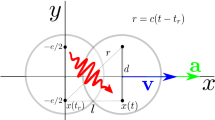In order to understand the rise of runaway solutions in the radiation reaction problem a mechanical model is used. An alternative demonstration of Daboul’s theorem, through Hurwitz’s criterion, is given. The origin of runaway solutions in electrodynamics is discussed. They arise when the particle has a negative mechanical mass or when approximations are used in the equation of motion. In the 1-dimensional mechanical model an exact and linear equation of motion for the particle is obtained, the corresponding exact solution is again runaway when the mechanical mass is negative. The exact solution is not runaway when the mechanical mass is positive. However, the use of approximations leads to an equation of motion which has runaway solutions. It is exhibited that the use of approximations in the 3-dimensional mechanical model is completely necessary because the general equation of motion for the particle is non-linear. The analysis of this case proceeds in a very similar way to the one carried out in electrodynamics. This means that the number of dimensions also plays an important role in the analysis.
Similar content being viewed by others
References
W. K. H. Panofsky and M. Phillips, Classical Electricity and Magnetism, 2nd edn. (Addison Wesley, Reading, Massachusetts, 1962). F. Rohrlich, Classical Charged Particles (Addison-Wesley, Reading, Massachusetts, 1965). J. D. Jackson, Classical Electrodynamics, 3rd edn. (Wiley, New York, 1999). J. L. Jiménez and R. Montemayor, Nuovo Cimento B 73, 246 (1983). J. L. Jiménez and I. Campos, Am. J. Phys.55, 1017 (1987). J. A. E. Roa-Neri and J. L. Jiménez, Found. Phys. Lett. 7, 403 (1994). R. Medina, J. Phys. A: Math. Gen. 39, 3801 (2006).
Pearle P. (1982). ”Classical electron models”. In: Teplitz D. (eds) Electromagnetism: Paths to Research. Plenum, New York, pp. 211–295
Burke W.L. (1971). J. Math. Phys 12: 401
Eliezer C.J. (1947). Rev. Mod. Phys 19: 147
Daboul J. (1974). Int. J. Theoret. Phys 11: 145
Oliver M.A. (1999). Found. Phys. Lett 12: 81
D. Bohm and M. Weinstein, Phys. Rev.74, 1789 (1948). J. D. Kaup, Phys. Rev. 152, 1130 (1966). B. H. Goedecke, Nuovo Cimento 28B, 225 (1975). B. H. Goedecke, Nuovo Cimento 30B, 108 (1975). H. E. Levine, E. J. Moniz and D. H. Sharp, Am. J. Phys. 45, 75 (1977). E. J. Moniz, and D. H. Sharp, Phys. Rev. 15, 2850 (1977). P. Caldirola, G. Casati and A. Prosperetti, Nuovo Cimento 43A, 127 (1978). H. M. França, G. C. Marquez, and A. J. Da Silva, Nuovo Cimento 48A, 65 (1978). J. L. Jiménez and I. Campos, Found. Phys. Lett. 12, 127 (1999). J. A. E. Roa-Neri and J. L. Jiménez, Found. Phys. 32, 1617 (2002).
Roa-Neri J.A.E., Jiménez J.L. (1993). Nuovo Cimento B 108: 853
Lorentz H.A. (1952). The Theory of Electrons and its Applications to the Phenomena of Light and Radiation Heat 2nd edn. Dover, New York
Uspensky J.V. (1948). Theory of Equations. McGraw-Hill, New York
de la Peña L., Jiménez J.L., Montemayor R. (1982). Nuovo Cimento B 69: 71
Smirnov A.Y. (1997). J. Phys. A: Math. Gen 30: 1135
Goldstein H. (1980). Classical Mechanics 2nd edn. Addison-Wesley, Reading, MA
Pauli W. (1973). Lectures on Physics. MIT, Cambridge
Author information
Authors and Affiliations
Corresponding author
Rights and permissions
About this article
Cite this article
Jiménez, J.L., Roa-Neri, J.A.E. & Vargas, P. A Mechanical Model for Analyzing the Runaway Solutions in the Radiation Reaction Problem. Found Phys 37, 410–426 (2007). https://doi.org/10.1007/s10701-007-9109-9
Received:
Revised:
Published:
Issue Date:
DOI: https://doi.org/10.1007/s10701-007-9109-9



